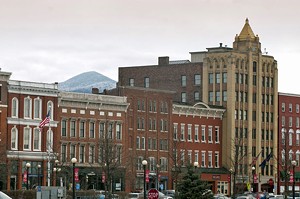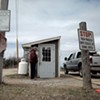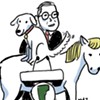Published February 1, 2012 at 10:55 a.m. | Updated November 30, 2020 at 4:29 p.m.
“Let’s talk about RutVegas.”
Jim Sabataso is sitting at a small table in Café Terra, “Rutland’s best coffee shop” — and only one, he admits.
Sabataso is 28 years old, bearded and friendly. His family goes back a long time in these parts: His great-grandparents emigrated from Italy and landed in Rutland; the Sabataso family has run the Palms restaurant downtown since 1933. Jim Sabataso is Rutland through and through.
Which brings us back to “RutVegas.” “That’s our word, not yours,” Sabataso says. He’s good-natured about it, but there’s something to this. The Marble City has a chip on its shoulder.
Defensive, a bit resistant to outsiders and staunchly self-reliant, Rutlanders bristle at the pejorative moniker and its attendant connotations. Perhaps with good reason: For decades, the blue-collar railroad town has battled a reputation as the unofficial capital of drugs and crime in Vermont. To outsiders, it’s a gritty place — the part of Vermont where your tires might get slashed. Where you should lock your doors. Where, at best, there’s not much to do.
Residents don’t deny that their city has its problems. But that reputation? It’s just not fair, they say — or accurate.
These days, something is undeniably afoot in Rutland. The city will break ground this spring on a new downtown pedestrian marketplace. Green Mountain Power, on the verge of a merger with Rutland-based Central Vermont Public Service, is promising to make Rutland the state’s “solar city,” with more solar power generated per capita than anywhere else in Vermont. Last month, the Community College of Vermont opened its brand-new, $8 million facility downtown.
Home prices are relatively low. Rent is cheap. And slowly, young people such as Jim Sabataso and Jacob Pluta — who, at 23, owns Rutland’s best and only coffee shop — are returning to the city they once left behind.
The youngest Sabataso gave the family biz a try but decided it wasn’t for him. Instead, he parlayed some sharp-eyed letters to the editor into a job at the Rutland Herald, and now edits and writes for a hyperlocal section called “The Express.”
“There’s a self-esteem issue in this town,” Sabataso says. “We’re our own worst enemy sometimes… You have to remind Rutland that we have a lot to be proud of.”
When he’s not working, Sabataso is volunteering: for Restoring Rutland, or the Downtown Rutland Partnership, or a new group trying to bring together young professionals in the city, or for Sustainable Rutland. (That last one sponsors events such as plastic-bag-free days — this, Sabataso says, in a city where “sustainability” was still something of a foreign word as recently as 2008.)
For someone who swore he was splitting town after high school — and who did leave for a time — Sabataso is knee-deep in the grassroots movement that is slowly revitalizing Rutland. It’s what more than one local calls a “pull-yourself-up-by-your-bootstraps” approach.
“Rutland’s not a ready-made community,” Sabataso says. “It’s still a work in progress.”
Here’s the first thing Rutlanders want you know about that “work in progress”: There’s no statistical truth to the perception that Rutland has greater problems with drugs or crime than Vermont’s other urban areas.
“The reputation — I don’t see that image, and I don’t live that image,” says Christopher Louras, the lanky, dark-haired and, by all accounts, extremely popular city mayor. “That’s an outsider’s view, and it’s a misplaced outsider’s view that I don’t put any stock in,” he adds. “And I say that with my eyes wide open to the problems that any … Vermont-scaled urban center is dealing with.”
Statewide, Chittenden County led the pack for the number of criminal offenses committed in 2010, followed by Rutland County. Factor in population, and offense rates were higher in Chittenden and Windham counties, with Rutland coming in third. Looking solely at drug offenses, the city of Burlington outpaced Rutland with 81 per 1000 residents in 2010, compared with 57 per 1000 residents in Rutland.
Even if the stats don’t bear out the stereotype, there’s no shortage of good stories to swap about Rutland’s supposed crime rash. Among the more sobering is that of a break-in and assault that happened a week and a half ago, when two men from New York and a 20-year-old Rutlander allegedly entered a home and assaulted two women and a man using golf clubs and a knife.
The story plays into a narrative familiar in Rutland, one that depicts drugs, and their associated crimes, as an epidemic flooding in from New York state. But again, fact and fiction don’t always line up. The rumors that drugs are coming in on the New York Amtrak train (nickname: Am-Crack) are just that: rumors, says Lynne Walsh, executive director of the community-justice organization Rutland United Neighborhoods.
Criminals aren’t the only ones making headlines: The city police department has come under scrutiny, too. In one case, a sergeant was charged with and later convicted of mishandling evidence and lying to police. Another patrolman resigned after allegedly using improper force on a man handcuffed in a holding cell.
In December, Chief of Police Anthony Bossi retired after months of debate among aldermen — who wanted Bossi out — and the police commission and rank-and-file officers. The city also placed two officers on administrative leave in December. Interim Chief James Baker says he’s managing a staff of 30 in a department that should have 39.
“I do think some of the negativity that has circled around the police department has led to some of the difficulties with staffing,” Baker says.
City leadership, and some residents, are circumspect when it comes to talking about changes in the police department. Sabataso puts an upbeat spin on recent developments: “I think the police department is in a moment of transition, and that’s a moment of opportunity.”
Baker agrees, pointing out that, as the most visible public servants in a city, police officers should be ambassadors to the public. “If there’s a perception that a city isn’t safe, then no one is going to come to that city,” the chief says.
Those perceptions come and go, says Walsh. But many who live in Rutland maintain that one of the biggest enduring issues is property crime fueled by drug habits.
Police say copper thefts are a problem in the city, as vandals sneakily strip abandoned residential and commercial properties of their fixtures, pipes and wiring. Copper prices are down since they peaked in 2008, but the scrap metal still holds the promise of quick cash.
“It’s easy money,” Walsh says.
Compounding the problem are absentee or irresponsible landlords — some who have left properties abandoned, and others who let their houses decay, rent to a transient population and do little to discourage what Walsh calls “five-minute traffic,” meaning people come and go at all hours.
She and others don’t diminish the problem Rutland has with drugs, and cite addiction — much of it fueled by poverty — as a central concern in the region. But, insists Walsh, it’s important to note that this is not a challenge unique to Rutland.
“I think this community also has a lot more positive things going on,” she says. “I wouldn’t have set down roots and decided to raise my family here if I didn’t think it was a good place to live.”
The story Mayor Louras would rather tell outsiders is this one: Bounded on all sides by Rutland Town — and the strip-mall development that characterizes this neighbor — the city has had to look inside its own borders for models of successful redevelopment. That neighboring development did come with heavy costs: Because the boundaries between town and city are unclear to outsiders, some city residents worry Route 7 sprawl unfairly overshadows an otherwise hidden historic downtown.
But Louras thinks the city will hold its own.
“Nationwide, municipalities are collapsing back upon themselves and their urban centers instead of embracing the strip development and suburban malls that had been the norm for the past 20 years,” he says. “We certainly aren’t going to return to the 1960s where the local downtowns were king, but there will be a renaissance.”
Tooling around town in his VW wagon, Louras points out a few success stories. Among them is Pine Hill Park, the brainchild of Michael Smith, a literal trailblazer. The network of trails is among the top 25 mountain-bike destinations in the country — and anyone in the city can reach the park in about five minutes. Then Louras heads up the hill to the old armory, recently vacated by the National Guard and, according to the mayor, “haunted as hell.” The city recently held a public meeting to discuss possible uses for the space. Louras’ goal? Get it back on the tax rolls. In both cases, he says, the trick is in seeing possibility where it doesn’t yet exist.
This is where Rutland boosters, such as Mark Foley, step in.
“I get a little bullish on Rutland,” Foley says, pausing for a breath after a lightning-quick explanation of his latest plans for property development.
He leads a march through a still-under-construction office space, perched high above the junction of Center Street and Merchants Row. The 3000-square-foot office smells of paint and dust, and late afternoon light from the west hits the exposed brick walls and structural trusses and beams. Foley calls this the “Loft,” and envisions an office-sharing and coworking space for professionals — part business incubator, part networking hub. There are tremendous views, both down to the street and out to the mountains in the distance.
Born and raised in Rutland, Foley is in the regional family business of linen and uniform rentals. More significantly, the Foleys are major property owners in Rutland, with 14 large, historic properties in the downtown district. And, sure enough, once he gets rolling, Foley is “bullish,” indeed. He waxes eloquent about the beautiful downtown and the dynamic Paramount Theatre, where he is president of the board of directors.
“Every [place] has empty storefronts,” Foley says, nipping in the bud the most common complaint he hears about the downtown. “But we have more square footage occupied this year than we did last, and more last year than we did the year before.”
Next he pops into the Center Street Alley — right now, an empty, barren courtyard tucked behind the Paramount. It’s an expansive space, first developed in the late 1970s as an outdoor courtyard. It never really took off, though — private investments fell through, and the space is underused. (“Horribly dysfunctional,” Louras says more bluntly.)
After years of planning, and a nearly $1 million earmark from Sen. Patrick Leahy, Rutland will break ground on an overhaul of the alley this spring or summer. City developers such as Foley imagine it as a green, shaded public marketplace, bordered by cafés and little shops. Right now the courtyard is surrounded by the towering backsides of buildings, including the theater and the seven-story Service Building. Foley unfurls some blueprints and shows how he plans to punch out the back of the building currently occupied by the Rutland Area Food Co-op. There will be outdoor seating for a café, he explains, and kitchen space for a new restaurant.
Finally, Foley leads the way to the intersection of West Street and Merchants Row, one of the busiest thoroughfares in downtown Rutland. On the way, he passes the Walmart, dropped square in the middle of the city. On the whole, most downtown bigwigs say it could have been worse. Locating the retail giant in the Rutland downtown saved the city from an even more pronounced exodus of shoppers to outlying developments.
Still, Foley and others want to see a more vibrant local shopping scene. Every year some 3.75 million vehicles pass through the crossroads at West and Merchants, making it arguably the most desirable downtown location. But, as of 2010, Foley says, three of the four corners were vacant. Today, all have tenants.
On one corner, already home to a women’s clothing boutique, Foley envisions developing the Shops at Gryphon Square, comprising food, electronics, and outdoor and sporting-goods stores.
Standing on the street corner, he talks about the proud heritage of Rutland. “We’re proud of it, and protective of it,” he says. Looking around the downtown, Foley adds, “I think we’re holding our own very well.”
It’s late afternoon by now, and shopkeepers are closing up. As a service hub for the region, and the seat for the superior and district courts, Rutland’s downtown is well populated during the day, Foley notes. The trick will be convincing shopkeepers to stay open a little longer, and luring customers back downtown to shop or dine.
His remark gets at what may be the biggest problem facing Rutland. Not drugs, not real estate — or lack thereof — or even blighted, ramshackle properties. It’s a matter of convincing.
“There’s just a general feeling of being passed over,” says Steve Terry, who worked as the managing editor of the Rutland Herald in the late 1970s and early ’80s. “It’s part of the psyche.”
Take the issue of the highway: You can’t spend much time in Rutland without hearing at least once about the interstate that never came. The town pushed hard for its own equivalent of I-89 — some 20th-century speedway snaking up the western corridor of the state to better connect the city with the rest of the world. Rutland is still waiting.
It wasn’t always this way. Rutland grew up in the 19th century, evolving from a small mill town on the Otter Creek into a bustling industrial center after the discovery of rich marble deposits in the region. The trains arrived in 1851, and soon Rutland was the railroad capital of the state and one of the world’s leading marble producers. The city still bears the marks of the turn-of-the-century boom times in its great, hulking churches and City Beautiful architecture.
But Rutland’s heyday came, as all good things do, to an eventual end. The city’s population has been dropping since its peak in 1970. Today, about 16,500 residents live within city limits — fewer than in 1930. The marble quarries shut down in the ’80s and ’90s. The railroad left. At one point in recent years, Rutland boasted the highest unemployment rate in the state. (These days, Rutland County’s unemployment rate — 5.4 percent — is just slightly higher than the state average.)
The city has 150 vacant properties on the books, and some of those residential and commercial buildings are abandoned and decaying, dragging down property values and tempting vagrants. The city is scrambling to draft an ordinance to deal with blighted properties. Drive Rutland’s neighborhoods, and you’ll find immaculately tended houses, outfitted with window boxes or wreathes, next to homes with broken windows and “No Trespassing” signs.
All this leaves Rutland in the position of many small, once-bustling industrial towns in America: casting around for what’s next. Finding that thing — green energy? Local foods? New farms? — and agreeing on it can be tough for a community divided between can-do youngsters and a population segment that’s reticent in the face of change. That’s where the convincing comes in.
“It’s that Yankee stubbornness,” says Sabataso. “Change can be hard sometimes.”
What’s certain is this: That feeling of being “passed over” means Rutland isn’t looking to anyone other than itself for reinvention.
When Tropical Storm Irene hit, for instance, a group of volunteers, including 27-year-old Katye Munger, rallied to create the impromptu Restoring Rutland group. They took over a downtown storefront and began stockpiling supplies. Within a few days, they had created a pipeline for funneling volunteers into neighboring, harder-hit communities.
“I’ve been, in the past couple of years, seeing such a force of younger community members trying to step up,” Munger says. “We’re trying to move Rutland forward in that positive direction.”
She’s not alone.
Back at Café Terra, Jacob Pluta slips into a seat near the front window. He’s not much used to sitting still these days; he bought the café about a year and a half ago. At the time, Pluta, a Rutland native, was a young graduate of McGill University. He moved to Burlington but couldn’t land a job there; though he considered opening a business in the bigger city, he says the stakes were just too high.
The low barrier to entry in Rutland inspired Pluta to gamble on buying a business, and his customers made it pay off. “They’ve been coming in since day one,” he says. “The town has been really supportive.”
Pluta is too young to have known Rutland at its apex. He does remember that the city of his childhood — in the 1990s — seemed a more prosperous place than the one he knew as a teenager. After years of empty storefronts — with their signs proclaiming “This space is not empty, it’s full of opportunity” — Pluta thinks the city is finding some momentum. “I think Rutland’s on the up-and-up,” he says.
The new head of Rutland Redevelopment Authority, Brennan Duffy, says the same thing. In economic speak, he calls it “spiraling” — and this time it’s an upward spiral.
That’s thanks in part to young entrepreneurs, to volunteers and to new blood in city government. At 51, Mayor Louras jokes that he’s an “old man” around city hall. These days the board of aldermen is skewing younger — a nice change of pace, says Sabataso, from the meetings he attended on first moving back to Rutland in 2007.
“You don’t see the board members like you had in the past who are either asleep through most of the meeting — I’m not joking — or just kind of, like, old-timers who are really out of touch, or people who don’t show up,” he says.
Could Rutland become a model for other small manufacturing cities, caught between memories of the city that was and visions of the city that could be?
Maybe, say rural-development experts such as Paul Costello, who helped jumpstart the “creative economy” conversations in 2005 and 2006 that paved the way for Rutland’s latest economic push.
“From a far distance out here in Montpelier, Rutland is seen today to be a town on the move,” Costello says. “We point to Rutland and we say, ‘Here’s a town that has really pulled together.’”
As executive director of the Vermont Council on Rural Development, Costello stepped in to guide the city’s early conversations about revitalization. Those centered on the idea of developing the creative economy, which involves making a place more innovative and exciting for young people and entrepreneurs. It’s what some in economic circles call “soft” development. Creative-economy projects may not translate into a new factory or dozens of new jobs, but they stand to improve a city’s overall health and vitality.
Costello says that Rutland residents turned out for those talks in overwhelming numbers, with as many as 400 people at some meetings. The goals the city identified in the beginning — including recreation, a more pedestrian-friendly downtown, strong farm and food links ,and sustainability — are guiding the major downtown revitalization projects under way now. The creative-economy conversation gave birth to Friday Night Live, a popular summer street festival during which Center Street is blocked off for a few hours. After the talks, the city also started Vermont’s first year-round farmers market, which is among the most vibrant in the state.
Rutland boosters say those examples only scratch the surface of the energy the city is mustering. They point with pride to the Gift of Life blood drive — this year, the second-largest single-day drive in the country. There’s the Halloween parade. There’s the way the city turned out after Irene. When it matters, residents say, the city pulls together.
“This town has a lot to give,” Sabataso says. “[That energy] exists here. It’s built into this community, and it’s just a matter of harnessing it.”
More By This Author
Speaking of...
-

Rutland to Host the Punk Rock Flea Market This Weekend
Feb 22, 2024 -

Vermont Scrambles to Open Five Facilities for Homeless Residents by April 1
Feb 7, 2024 -

Mad Rose Cocktail Lounge Opens in Rutland
Aug 1, 2023 -

Jones' Donuts Celebrates 100 Sweet Years in Rutland
Jul 11, 2023 -

Photo Essay: Family-Owned Mac Steel in Rutland Closes After 70 Years
Apr 5, 2023 - More »
Comments
Comments are closed.
From 2014-2020, Seven Days allowed readers to comment on all stories posted on our website. While we've appreciated the suggestions and insights, right now Seven Days is prioritizing our core mission — producing high-quality, responsible local journalism — over moderating online debates between readers.
To criticize, correct or praise our reporting, please send us a letter to the editor or send us a tip. We’ll check it out and report the results.
Online comments may return when we have better tech tools for managing them. Thanks for reading.
















































